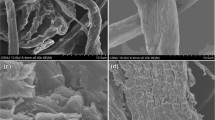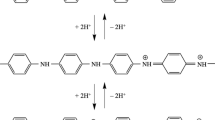Abstract
A cellulose-graft-poly(methyl acrylate) was synthesized by free radical initiating process and the ester functional groups were converted into the hydroxamic acid ligand. The intermediate and final products are characterized by FT-IR, FE-SEM, HR-TEM and XPS technique. The pH of the solution acts as a key factor in achieving optical color signals of metalcomplexation. The reflectance spectra of the [Cu-ligand]n+ complex was found to be a highest absorbance at 99.8 % at pH 6 and it was increased upon increasing of Cu2+ ion concentrations and a broad peak at 700 nm was observed which indicated the charge transfer (π-π transition) metals-Cu complex. The adsorption capacity of copper was found to be superior (336 mg g−1) rather than other transition metals such as Fe3+, Co3+, Cr3+, Ni2+, Mn2+ and Zn2+ were 310, 295, 288, 250, 248 and 225 mg g-1, respectively at pH 6. The experimental data of all metal ions fitted significantly with the pseudo-second-order rate equation. The transition metal ions sorption onto ligand were well fitted with the Langmuir isotherm model (R2>0.99), which suggested that the cellulose-based adsorbent known as poly(hydroxamic acid) ligand surface is homogenous and monolayer. The reusability of the poly(hydroxamic acid) ligand was checked by the sorption/desorption process up to ten cycles without any significant loss in its original sensing and removal performances.
Similar content being viewed by others
References
E. Wilkins and Q. Yang, J. Environ. Sci. Health Part AToxic/Hazard. Subst. Environ. Eng., 31, 2111 (1996).
N. V. Narayanan and G. Mahesh, J. Hazard. Mater., 161, 575 (2009).
W. S. S. Yong, M. R. Lutfor, S. E. Arshad, N. L. Surugau, and B. Musta, J. Appl. Polym. Sci., 124, 4443 (2012).
S. Kamel, E. M. Hassan, and M. El-Sakhawy, J. Appl. Polym. Sci., 100, 329 (2006).
M. R. Lutfor, S. Silong, W. M. Z. Wan Yunus, M. Z. A. Rahman, M. Ahmad, and J. Haron, Eur. Polym. J., 36, 2105 (2000).
A. Bhattacharya and B. N. Misra, Prog. Polym. Sci., 29, 767 (2004).
G. Gurdag, M. Yasar, and M. A. Gurkaynak, J. Appl. Polym. Sci., 66, 929 (1997).
M. R. Lutfor, S. Silong, W. M. Z. Wan Yunus, M. Z. A. Rahman, M. Ahmad, and J. Haron, J. Appl. Polym. Sci., 79, 1256 (2001).
M. R. Awual, T. Yaita, S. A. El-Safty, H. Shiwaku, H. Suzuki, and Y. Okamoto, Chem. Eng. J., 221, 322 (2013).
M. R. Awual, M. M. R. Ismail, T. Yaita, M. A. Khaleque, and M. Ferdows, Chem. Eng. J., 236, 100 (2014).
F. L. Chuan, L. R. Jun, X. Feng, J. L. Jina, X. S. Jin, and C. S. Run, J. Agric. Food Chem., 54, 5742 (2006).
Y. K. Agrawal, Russ. Chem. Rev., 48, 948 (1979).
D. Hall and F. J. Llewellyn, Acta. Cryst., 9, 108 (1956).
D. W. O’Connell, C. Birkinshaw, and T. F. O’Dwyer, J. Chem. Technol. Biotechnol., 81, 1820 (2006).
M. R. Lutfor, N. N. M. Rohani, and M. M. Yusoff, J. Appl. Polym. Sci., 131, 40833 (2014).
M. Eigen and K. Tamm, and Z. Elektrochem, Angew. Phys. Chem., 66, 107 (1962).
M. Eigen and R. G. Wilkins, Adv. Chem. Ser., 49, 55 (1965).
R. G. Wilkins, Inorg. Chem., 3, 520 (1964).
L. Helm and A. E. Merbach, Coord. Chem. Rev., 187, 151 (1999).
M. R. Beccia, B. García, J. G. Tojal, J. M. Leal, F. Secco, and M. Tegoni, Dalton Trans., 43, 9271 (2014).
P. Wanga, M. Du, H. Zhu, S. Bao, T. Yang, and M. Zou, J. Hazard. Mater., 286, 533 (2015).
R. S. Norouzian and M. M. Lakouraj, Synth. Met., 203, 135 (2015).
G. A. Hope, R. Woods, G. K. Parker, A. N. Buckley, and J. McLean, Inorg. Chim. Acta, 365, 65 (2011).
Y. Zhao, X. Wang, J. Li, and X. Wang, Polym. Chem. DOI: 10.1039/c5py00540j (2015).
M. Liu, Y. Deng, H. Zhan, and X. Zhang, J. Appl. Polym. Sci., 84, 478 (2002).
K. S. Low, C. K. Lee, and S. M. Mak, Wood Sci. Tech., 38, 629 (2004).
D. W. O’Connell, C. Birkinshaw, and T. F. O’Dwyer, J. Appl. Polym. Sci., 99, 2888 (2006).
D. W. O’Connell, C. Birkinshaw, and T. F. O’Dwyer, Bioresour. Technol., 99, 6709 (2008).
S. T. Lee, F. L. Mi, Y. J. Shen, and S. S. Shyu, Polymer, 42, 1879 (2001).
Z. Yanmei, J. Qiang, Z. Tianwei, and A. Yoshifumi, J. Hazard. Mater., 187, 303 (2011).
Z. Yanmei, H. Xiaoyi, Z. Min, Z. Xiaofeng, and N. Jiangyang, Ind. Eng. Chem. Res., 52, 876 (2013).
K. K. A. Santhana, S. Kalidhasan, R. Vidya, and N. Rajesh, Ind. Eng. Chem. Res., 52, 11838 (2013).
S. Vandana, K. S. Ajit, and M. Sadhana, Ind. Eng. Chem. Res., 48, 4688 (2009).
T. S. Anirudhan and S. R. Rejeena, Ind. Eng. Chem. Res., 50, 13288 (2011).
Author information
Authors and Affiliations
Corresponding author
Rights and permissions
About this article
Cite this article
Rahman, M.L., Mandal, B.H., Sarkar, S.M. et al. Synthesis of poly(hydroxamic acid) ligand from polymer grafted khaya cellulose for transition metals extraction. Fibers Polym 17, 521–532 (2016). https://doi.org/10.1007/s12221-016-6001-2
Received:
Revised:
Accepted:
Published:
Issue Date:
DOI: https://doi.org/10.1007/s12221-016-6001-2




